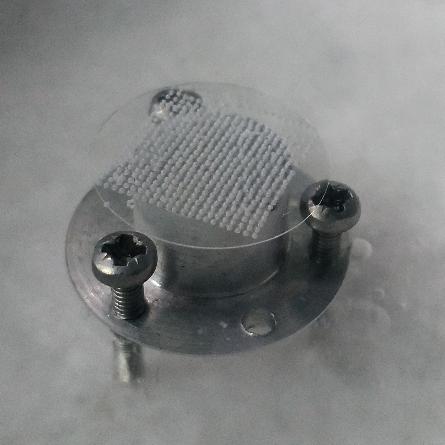A freezing method to keep cells alive without a cryoprotectant agent

Credit: Copyright © 2019 National Academy of Sciences
A team of Japanese researchers has – for the first time – demonstrated preserving frozen animal cells without a cryoprotectant agent (CPA), a substance that can protect biological material from freezing damage. To keep cells alive, all the conventional freezing methods needed to add a CPA, which can be potentially toxic and associated with cell damage and death. Their method only relies on ultrarapid cooling – or really fast freezing – that keeps cells and vital biological material during freezing process. A safe freezing without CPA method would not only revolutionize how important research and medical material is stored, but greatly advance any and all research methods within those fields.
The study was published in Proceedings of the National Academy of Sciences (PNAS) on April 1st, 2019.
The aim of cryopreservation – or storing in low temperatures – is to maintain biological materials, including tissues, mammalian cells, bacteria, fungi, plant cells, and viruses. These also include stem cells, sperm and embryos, all of which may subsequently be used for research and/or clinical purposes. When performed correctly and taking into account cell and tissue specific criteria, cryopreservation is an effective means for continuous and long-term storage and thereby availability of tissues and genetically stable living cells for academic, industrial, and clinical research. In order to keep frozen cells alive, the water inside and outside of those cells must be vitrified or turned into really small crystal structures. So far, this has been achieved by adding to the medium at least one CPA.
For this study, the researchers were able to freeze the cells quickly and achieved vitrification similarly to the use of CPA. “Ultrarapid cooling is much faster than the cooling rate that is typically used in cryopreservation. We call it superflash freezing, and it can almost vitrify and cryopreserve living cells without any cryoprotectant agent,” says Yoshitake Akiyama, PhD, corresponding author and Associate Professor of Department of Mechanical Engineering and Robotics, Faculty of Textile Science and Technology, Shinshu University.
The critical cooling rate required for CPA-free ultrarapid freezing is 10000 degrees C per second, and the researchers, in order to achieve it, used the inkjet cell printing technology. With this inventive approach, they repeatedly experimented how they could minimize the object of freezing and finally found that “superflash freezing” was realized with droplet sizes below 40 picoliter.
The researchers tested their CPA-free procedure by ultrarapid cooling one kind of mouse cells and obtained results that are very comparable to freezing with CPA. The method was further confirmed on a different mouse cell line and rat mesenchymal stem cells thereby demonstrating both efficacy as well as broad applicability.
In the future, the researchers hope to apply their method to preserve various types of cells, including those that have been particularly sensitive to the cryopreservation procedure. “We plan to use out method to cryopreserve other cells including pluripotent stem cells, whose properties such as stemness and differentiation are known to be susceptible to CPAs. Furthermore, we believe that our method might be suitable for cells such as hemocytes that cannot be stored by a conventional cryopreservation method,” Professor Akiyama adds.
###
This research was supported in part by several Japan Society for the Promotion of Science (KAKENHI) grants and by the Research Grant on Regulatory Harmonization and Evaluation of Pharmaceuticals, Medical Devices, Regenerative and Cellular Therapy Products, Gene Therapy Products, and Cosmetics from the Japan Agency for Medical Research and Development.
About Shinshu University
Shinshu University is a national university in Japan founded in 1949 and working on providing solutions for building a sustainable society through interdisciplinary research fields: material science (carbon, fiber, composites), biomedical science (for intractable diseases, preventive medicine), and mountain science. We aim to boost research and innovation capability through collaborative projects with distinguished researchers from the world. For more information, please see: http://www.
Media Contact
Nobuko Imanishi
[email protected]
Related Journal Article
http://dx.




